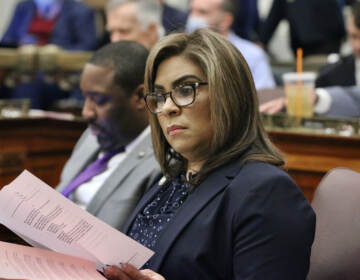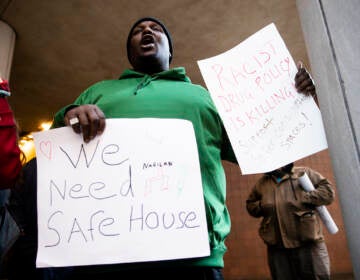What counts as saving a life? United States v. Safehouse kicks off
Lawyers for the nonprofit proposing a supervised injection site compared it to ERs, syringe exchanges. U.S. attorneys said the difference is they’re legal.
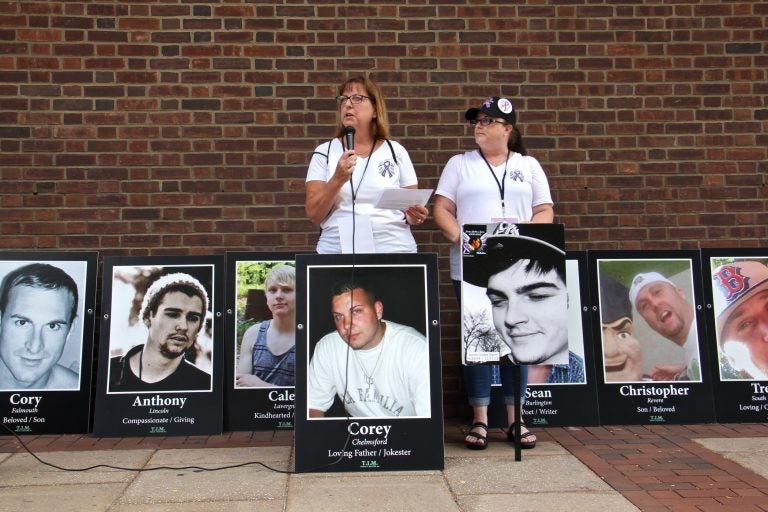
Cheryl Juaire (left) and Tracy Martin of Team Sharing, a national support group for parents of overdose victims, speak at a rally outside the federal courthouse in Philadelphia in support of supervised injection sites. (Emma Lee/WHYY)
What counts as saving a life? That was a central question at Monday’s opening hearing in federal court on Safehouse’s proposal to open a supervised injection facility in Kensington.
U.S. Attorney William McSwain sued the nonprofit in February, claiming its intended activities would violate the federal Controlled Substances Act. Safehouse has argued that the law does not apply because its main purpose is saving lives, not providing illegal drugs. U.S. District Judge Gerald McHugh requested the evidentiary hearing to learn more about how the facility would work.
As the hearing opened Monday morning, the courtroom was full, and dozens of supporters of supervised injection demonstrated outside, holding large, poster-sized photographs of loved ones lost to overdose.
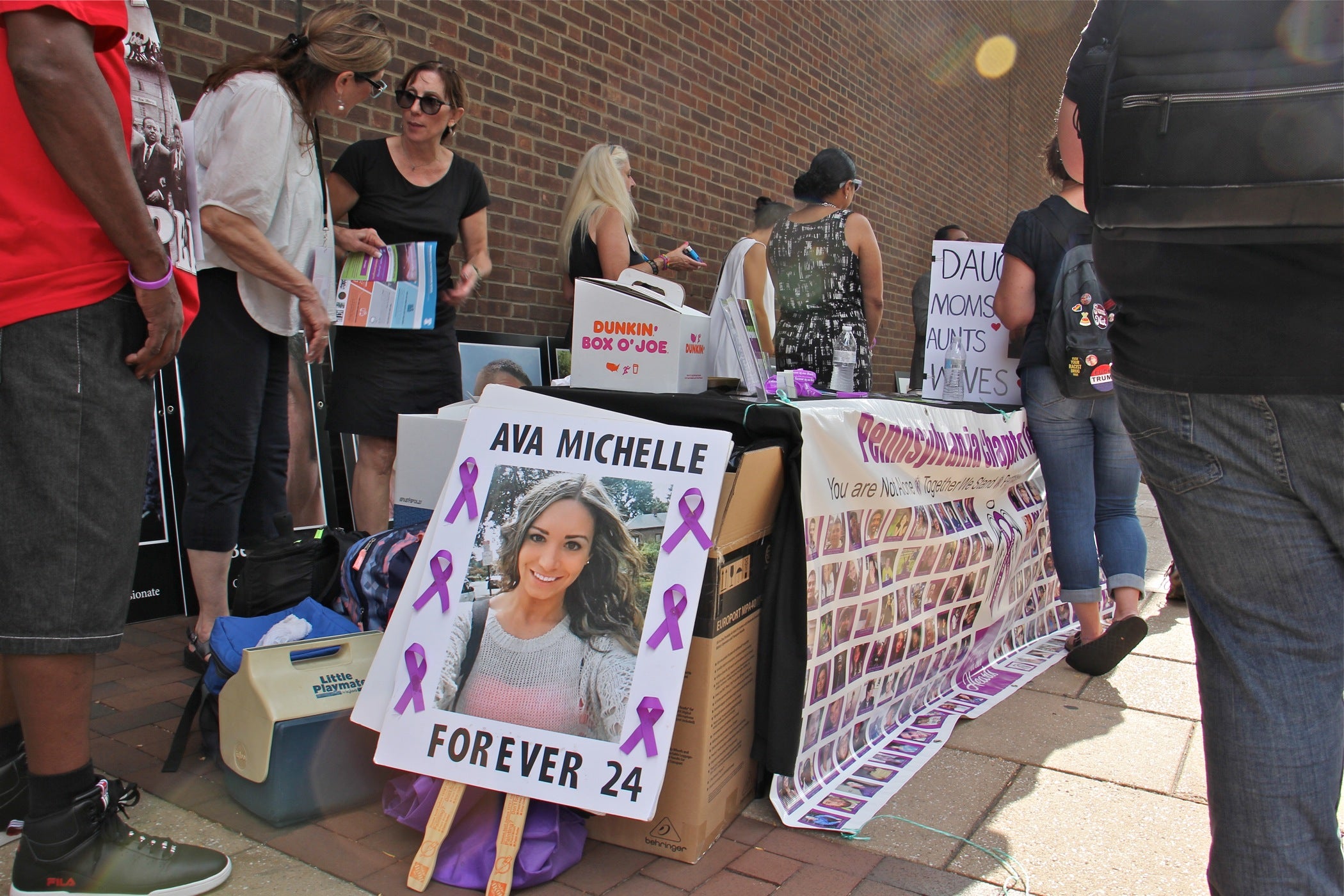
Safehouse’s legal team, led by Ilana H. Eisenstein, called three witnesses who are currently employed at existing organizations whose services are similar to those Safehouse plans to offer. That was the thrust of Eisenstein’s argument: that Safehouse wouldn’t be that different from the way medical professionals are already responding to the opioid crisis in Philadelphia, where more than 1,100 people died of overdoses last year.
Jeanmarie Perrone, an emergency medicine doctor and board-certified addiction specialist at Penn Presbyterian Medical Center, testified that she responds to two to three overdoses a week there.
It can take as little as one minute for an overdose to cause breathing to stop, Perrone said. As the flow of oxygen to other parts of the body slows, severe brain damage can occur, she said. Heart rate often stops completely after four minutes. She stressed the importance of responding to someone with naloxone, the overdose-reversal drug, as soon as possible, and recounted having to tell parents of young people that their children hadn’t made it to the emergency room in time.
“You can only do that so many times before you think something has to change,” she testified.
Perrone also described the practice of warm handoffs, which her emergency department does its best to facilitate. The idea is to connect someone who is in the throes of addiction with treatment and social services while they are in the hospital after an overdose. Offering someone the chance to stabilize and make a decision about treatment is critical in interrupting the revolving door between using drugs and avoiding withdrawal, she said.
“When you’re in the cycle of continuously using, you really can’t get to the next step,” Perrone said.
Safehouse has said that in addition to offering people a supervised room in which to inject drugs, it would also facilitate connections to social services and medication-assisted treatment on site.
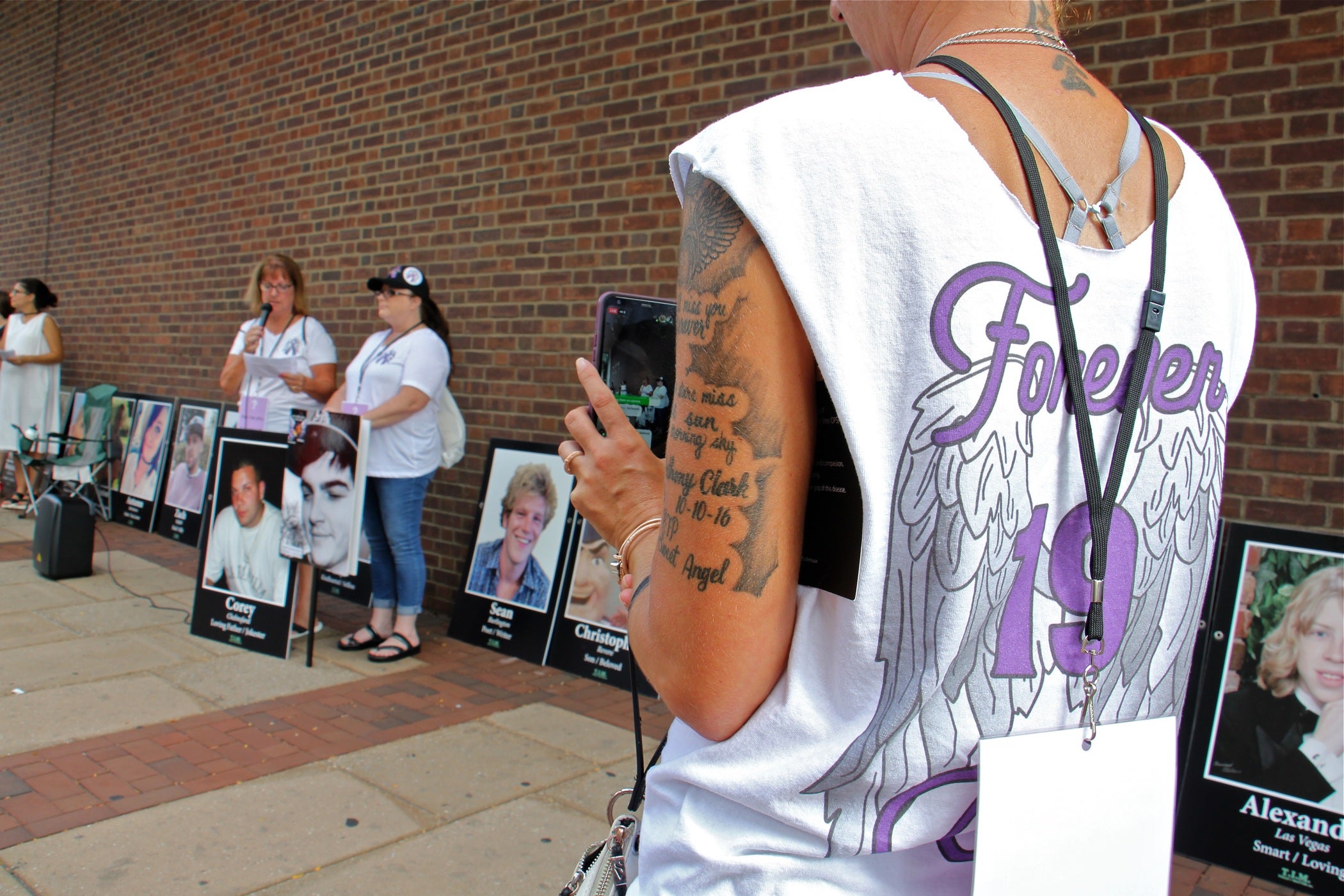
Jose Benitez, a founding Safehouse board member and the named defendant in the federal case against the nonprofit, compared the services that the 28-year-old syringe exchange Prevention Point already offers to what Safehouse would do. Benitez is executive director at Prevention Point, which he said saw its clientele go from roughly 2,500 people a year to 15,000 people annually in the last few years.
In addition to offering clean syringes and kits for safe consumption, Prevention Point offers the wraparound services — connections to housing, health care, free meals and medication-assisted treatment — that Safehouse would, Benitez testified. Plus, it responds to overdoses happening in the neighborhood. Every day, Benitez said, a team of three Prevention Point staff members is assigned as an overdose-response crew, to run out and attend to people who overdose in the neighborhood. He said there’s a backup crew in case more than one overdose occurs simultaneously.
In 2018, Benitez testified, Prevention Point staff reversed 500 overdoses using naloxone. He said that the same would follow at Safehouse, but that staff would be able to get to someone overdosing in a matter of seconds instead of a matter of minutes because there would be medical personnel watching over people as they injected. As stationary medical personnel, they would also be equipped with more lifesaving equipment, he said, like defibrillators, because the run-out crews can’t carry those with them.
Benitez added that the Safehouse board has not decided whether the facility would function on its own or as a part of an existing institution. That depends, in part, on the result of the litigation.

Because the services offered by Safehouse also would include connecting those patients who want it to the low-grade opioid buprenorphine, Philadelphia Fight’s infectious-disease physician Laura Bamford closed out the day’s testimony by describing in detail the protocol for administering medication-assisted treatment.
She said the observation-room component of Safehouse, where people could be monitored after using or after being revived with naloxone, could offer a good opportunity to talk to someone about treatment. In her clinical experience, Bamford said, it’s easier to ask someone to consider their options when they’re not uncomfortable and irritable due to withdrawal symptoms, and can be more relaxed.
Throughout their testimony, the witnesses called on Safehouse’s behalf said its services would be geared toward overdose prevention, not at facilitating drug use — a distinction that will matter more during oral arguments concerning whether Safehouse is permitted under the U.S. Controlled Substances Act. Those oral arguments, the next step in the court proceedings, are scheduled for Sept. 5.
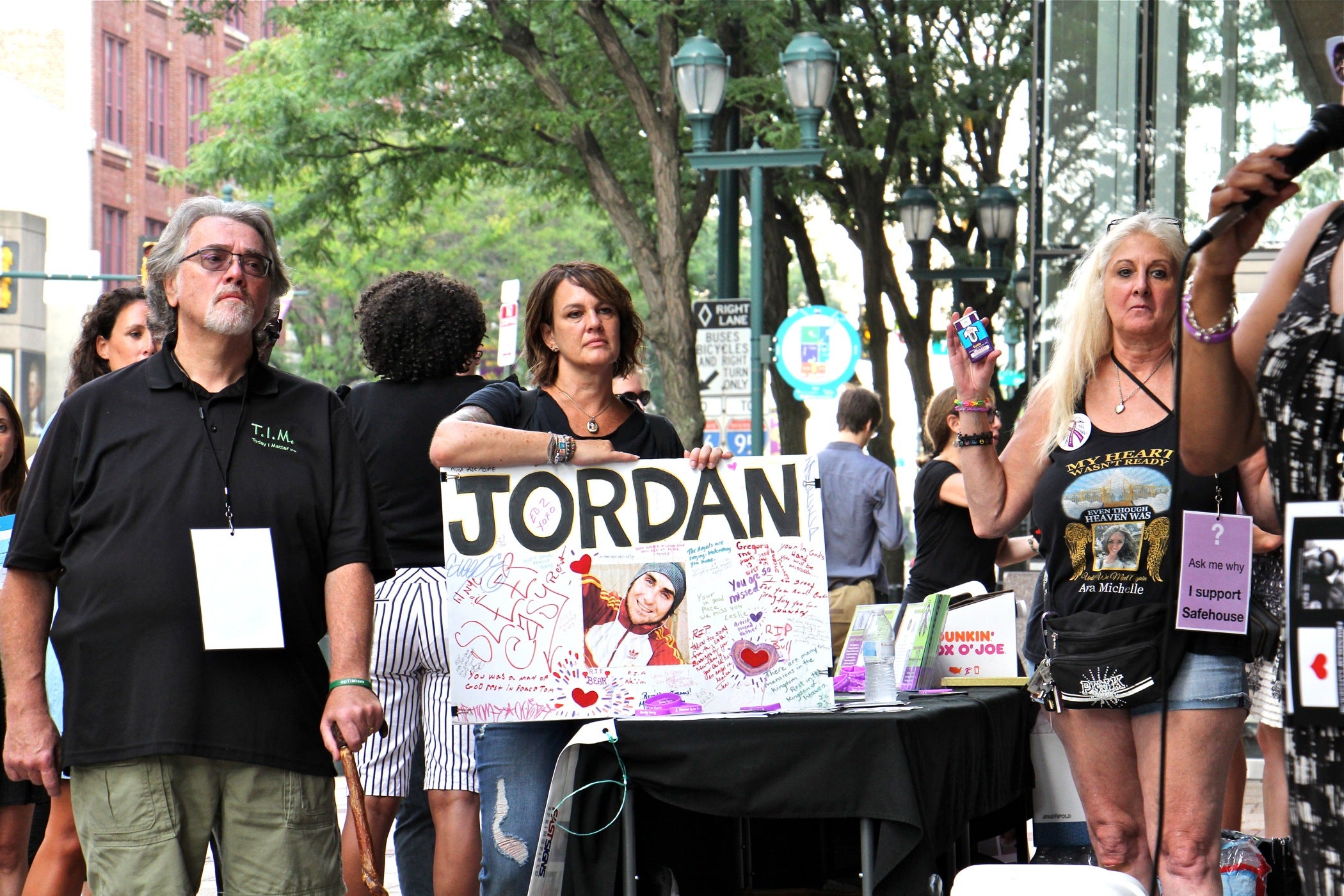
Judge McHugh asked several questions of Benitez on the bench. He wanted to know how Safehouse would be advertised (word of mouth); whether the demographic and behavioral health assessment questions asked at intake would be repeated each time someone came in (yes); and whether any of the literature Safehouse planned on offering outlined the adverse consequences of drug use (not so far.)
McHugh got into some of the nitty-gritty, asking whether a staff person would help if a patient said they couldn’t find a vein. Benitez said that there would be no physical contact allowed, but that a moment like that could serve as an “educational opportunity.”
In their cross-examination, attorneys for the federal government stressed in several ways that Safehouse should not be able to allow illegal drug consumption without government permission or oversight.
They accused Safehouse of being deceptive in its application to the Internal Revenue Service for 501(c)(3) status as a nonprofit because it did not mention that the Justice Department opposed such a site, and asked multiple witnesses why, if they knew the federal government opposed such a site, they had not gone the legislative or congressional route to try to get the law changed. For their part, Safehouse’s witnesses and attorneys maintained that they believe they are acting within the scope of the law.
Assistant U.S. Attorney Bryan Hughes noted that in Canada, Insite Vancouver, the most researched of North America’s supervised injection facilities, had received a special exemption from the government to operate.
Former Pennsylvania governor, Philadelphia mayor and Safehouse board member Ed Rendell said that was disingenuous.
“If they say we’ll be granted an exemption in two months, we’ll stop and we’ll apply for the exemption,” he said. “But every month we wait, other kids die.”
Rendell, as mayor, was responsible for sanctioning Prevention Point’s syringe exchange program through executive order. Prior to the order, such an exchange had been illegal in the city.

McSwain posited that the name Safehouse, and the comfort it implies, might encourage new users.
“Might that cause someone who is contemplating taking heroin the first time to do it at Safehouse?” he asked Benitez.
Benitez responded that in his 11 years working at Prevention Point, he has never encountered someone using the services there who was injecting drugs for the first time.
Attorneys for the federal government asked witnesses whether buprenorphine, a controlled substance with medically accepted use as a treatment for opioid use disorder, would be stocked on site, and what staff would do if a minor came in to use drugs. In his testimony, Benitez said doctors would only write prescriptions for the drug, not store it on site. He said they would do their best to connect minors with other services and not permit them to use if they were identified as being under 18.
Counsel for the government also asked about the presence of fentanyl test strips, which would be used by drug users, not staff, to detect the presence of fentanyl in the drugs being injected on site, but not its quantity.
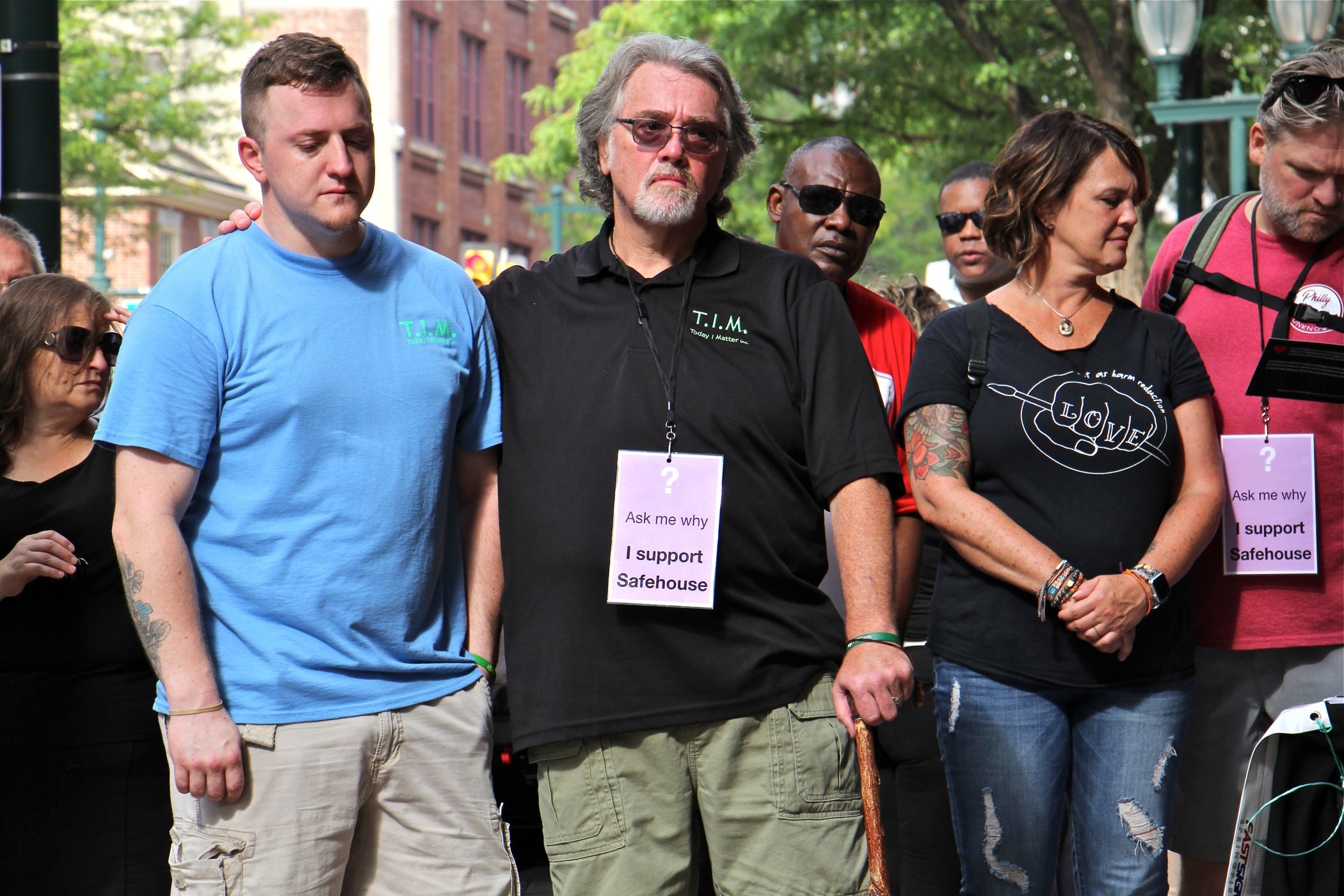
In an effort to demonstrate how difficult it would be to predict the potential impact of Safehouse and how that might be measured, McSwain cited a study conducted by researcher Sharon Larson that found that in Vancouver, the overdose rate has gone up in recent years, despite the presence of Insite. He questioned Benitez whether Prevention Point’s 500 overdose reversals in 2018 should really count as “lives saved” — which McSwain put in air quotes — since those same individuals could simply go and inject again the next day outside the observation of Safehouse, and then die of an overdose.
Benitez said that he considered an overdose reversal a life saved, regardless of what happened afterward. He invoked a common refrain used by harm-reduction advocates: “You can’t go into treatment if you’re dead.”
WHYY is your source for fact-based, in-depth journalism and information. As a nonprofit organization, we rely on financial support from readers like you. Please give today.



